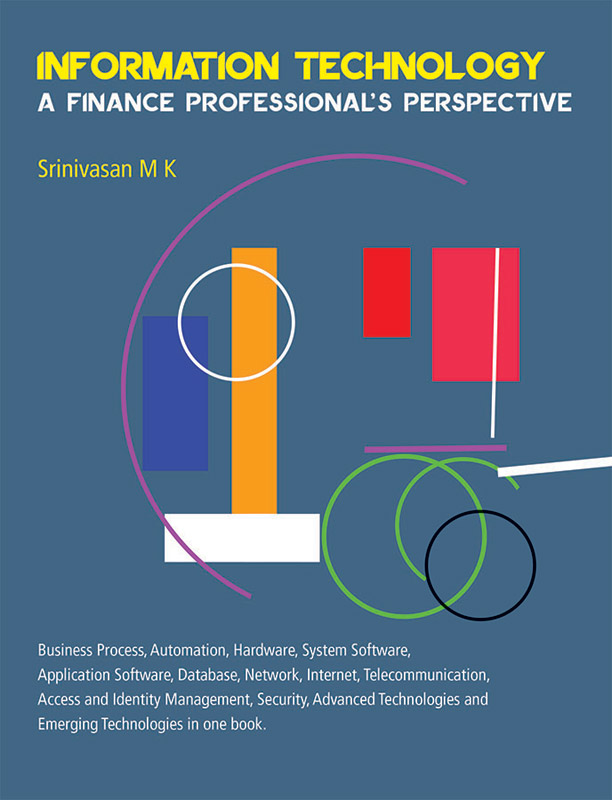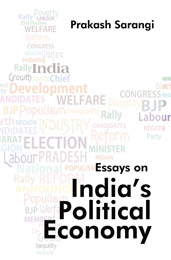The book 'Information Technology - A Finance Professional's Perspective' written by Srinivasan M K is to help the finance professionals to equip themselves with concepts and application of Information Technology in one's profession.
Over the years, finance and auditing professionals' work is deeply intertwined with information technology as more and more computer applications are deployed in business. Therefore, besides knowledge of finance and auditing, finance professionals are expected to acquire knowledge and develop understanding of information and emerging technologies and its impact on business.
The book has been written to address the needs of wide variety of readers ranging from students pursuing public accounting, cost accounting, management accounting, internal auditing courses through experienced professionals such as controllers & CFOs.
International Federation of Accountants (www.ifac.org) stipulates the need for professional accountants to possess knowledge of Information Technology by certified and accredited finance professionals at a specified level based on one's role.
This book has been written to provide knowledge on fundamentals of Business Processes, Information Technology concepts and on overview of advanced & emerging technologies.
The contents of the book have been organized into nine different sections from Finance perspective of IT through Business process & automation, BPR, Computer system & auditing in IT environment, Network-Internet-Telecommunication, Business systems, Deploying business application software, Access & Identity Management, Advanced & Emerging Technologies. Contents have been developed to explain the subject to a non-technical reader, in a simple language. The concepts have been explained with appropriate examples and applications along with diagrams to detail the principles for better visual understanding.
M K Srinivasan
Srinivasan M K (MKS) is a well accomplished professional in strategy consulting, technology consulting, financial management, information management, complex project management, client relationship and learning services.
He is a thought leader and an experienced senior executive with rich experience over three decades. He has deep experience in both traditional economy enterprises such as banking, mutual fund, engineering, trading enterprises and also in modern economy enterprises such as Business & Technology consulting, Information Technology Services. His work experience has the optimal mix from Indian public sector (BHEL), Indian private sector (Godrej, Thermax) and Multinational corporations such as BHA Group (now part of GE Energy), Deloitte and IBM.
Besides experience in India, work experience of MKS includes handling business in Europe and US, through short and long term assignments in IBM as Global Delivery Project Executive.
Academically, he holds a bachelor degree in Commerce from University of Madras and Associate Member of Institute of Cost Accountants of India (ACMA) graduating Cost and Management Accounting (CMA) program from the Institute.
MKS is a strong believer in continual learning and he has the following accreditation
? SAP certified FI/CO solution consultant
? PMI certified Project Management Professional
? IBM certified senior Project manager (complex project management)
? Stanford certified in Advanced Project Management with specialization in ‘Strategic Eexeuction’ (Stanford certified project manager – SCPM)
? IBM Certified Big Data & Analytics Solution Advisor
He is currently practicing as a Management consultant focusing on ‘Strategy’, ‘Information’ and ‘Learning’ needs of growing enterprises. In addition, he is also part of strategic leadership team of select enterprises
MKS is a strong believer that knowledge is for dissemination, hence written this book for giving back his knowledge and experience to profession and the society.
Contents
Terms of Use
Acknowledgements
Preface i
Section 1: IT: Finance Perspective
1.1 Background
1.2 Accounting Processes History: ‘Book & Ledger’ to ‘Click & Close’
1.3 Volatility, Uncertainty, Complexity and Ambiguity (VUCA)
1.4 Impacts of Various Changes on Finance Profession
1.5 What not to Expect from this Book
Section 2: Business Process and Automation
2.1 Background
2.2 Business Process Management
2.3 Overview of Business Process and Process Flow
2.4 Classification of Business Processes
2.5 BPM Implementation
2.6 Accounting System Automation
2.7 Impact of IT on BPM and Risk of Failure of IT
Section 3: Business Process Reengineering and Approaches
3.1 Background
3.2 Business Process Reengineering (BPR)
3.3 Process-Mapping Approaches
Section 4: Computer Systems & the Auditing IT Environment
4.1 Background
4.2 Need for Information Technology
4.3 Computing
4.4 Technology of Computing
4.5 Hardware
4.6 System Software
4.7 Application Software
4.8 Database Management System (DBMS)
4.9 Importance of IT in Auditing
Section 5: Network, Internet and Telecommunication
5.1 Background
5.2 Network Architecture
5.3 Network Computing
5.4 Protocols and Internet Architecture
5.5 Network Risks, Controls and Security
5.6 Network Administration and Management
5.7 Internet Revolution
5.8 Trends in Telecommunication
5.9 Business Value of Telecommunication
5.10 Telecommunication Networks
5.11 Electronic Commerce
5.12 Mobile Commerce
5.13 Electronic Funds Transfer
Section 6: Business System
6.1 Background
6.2 IT: The Key Business Enabler and Driver
6.3 Information System
6.4 Organisation, Business Processes and Information System
6.5 The Information System’s Role in a Business
6.6 Types of Information System
6.7 Specialised Systems
6.8 Expert System
6.9 Business Intelligence
Section 7: Deploying Business Applications Software
7.1 Background
7.2 Business Process Automation
7.3 System Development Life Cycle (SDLC)
7.4 Information Processing
7.5 Delivery Channels
7.6 BPA Controls
Section 8: Access and Identity Management
8.1 Background
8.2 Identity Management
8.3 Authentication
8.4 Authorisation
8.5 Accountability
8.6 Payment Mechanisms
8.7 Payment Process of an Online e-Commerce Transaction
8.8 How does a Credit Card Transaction Work?
8.9 Merchant’s Claim Clearing and Settlement
8.10 Transactions between Customer and Banks
Section 9: Advanced and Emerging Technologies
9.1 Advanced Technologies
9.2 Emerging Technologies: Cloud, Mobile, Virtualisation, Big Data, Artificial Intelligence, Wearable and IoT


 Political Science
Political Science


